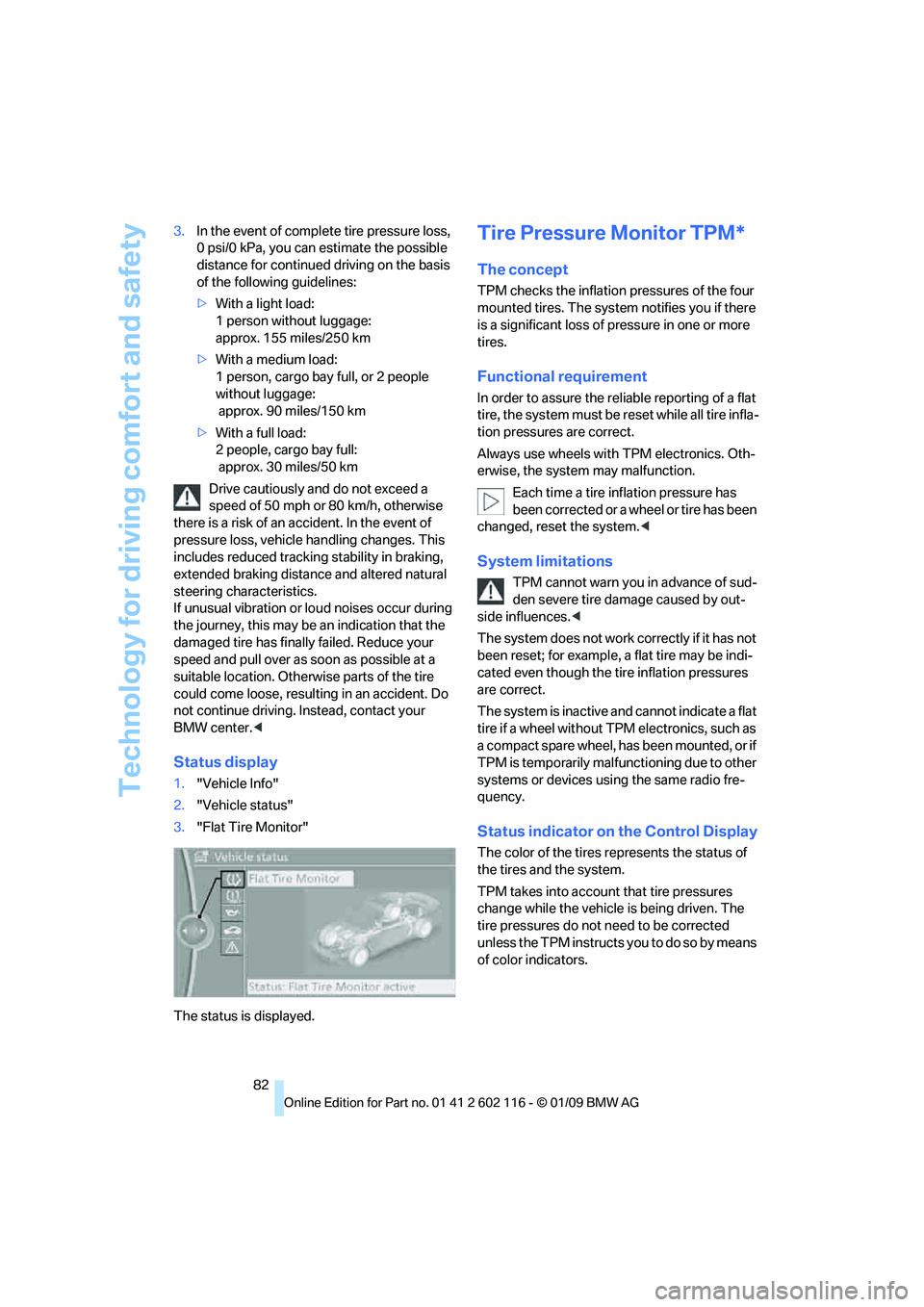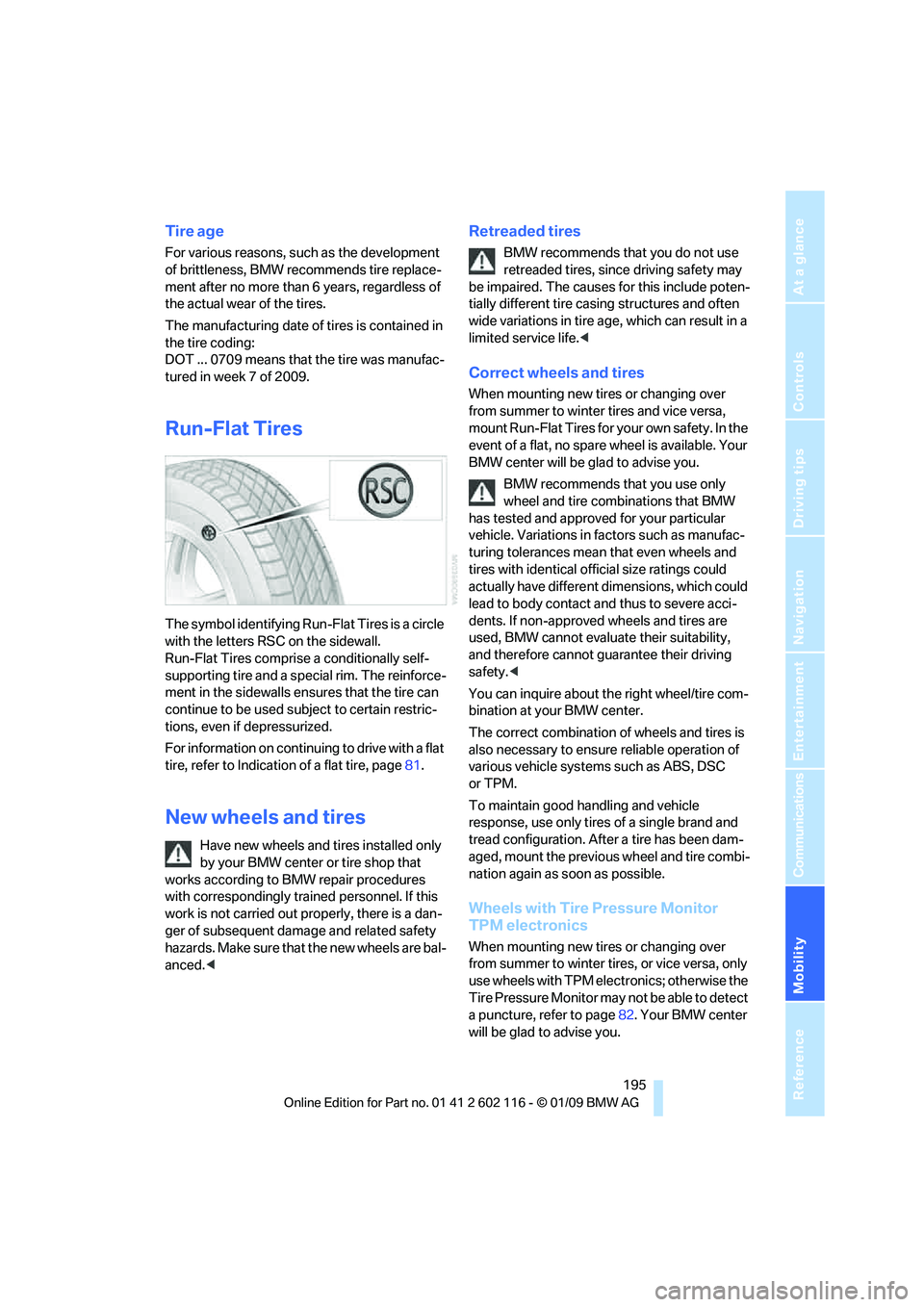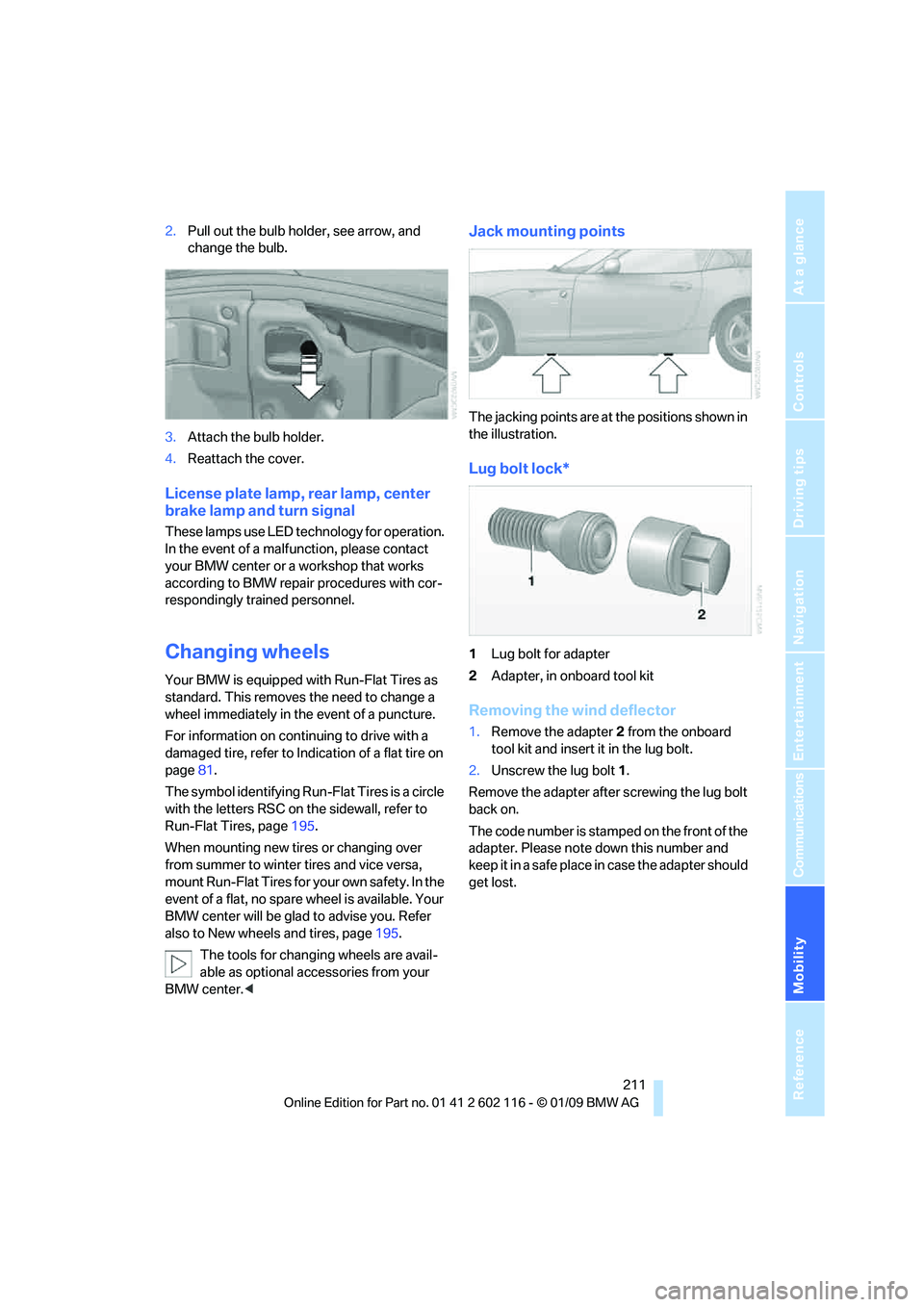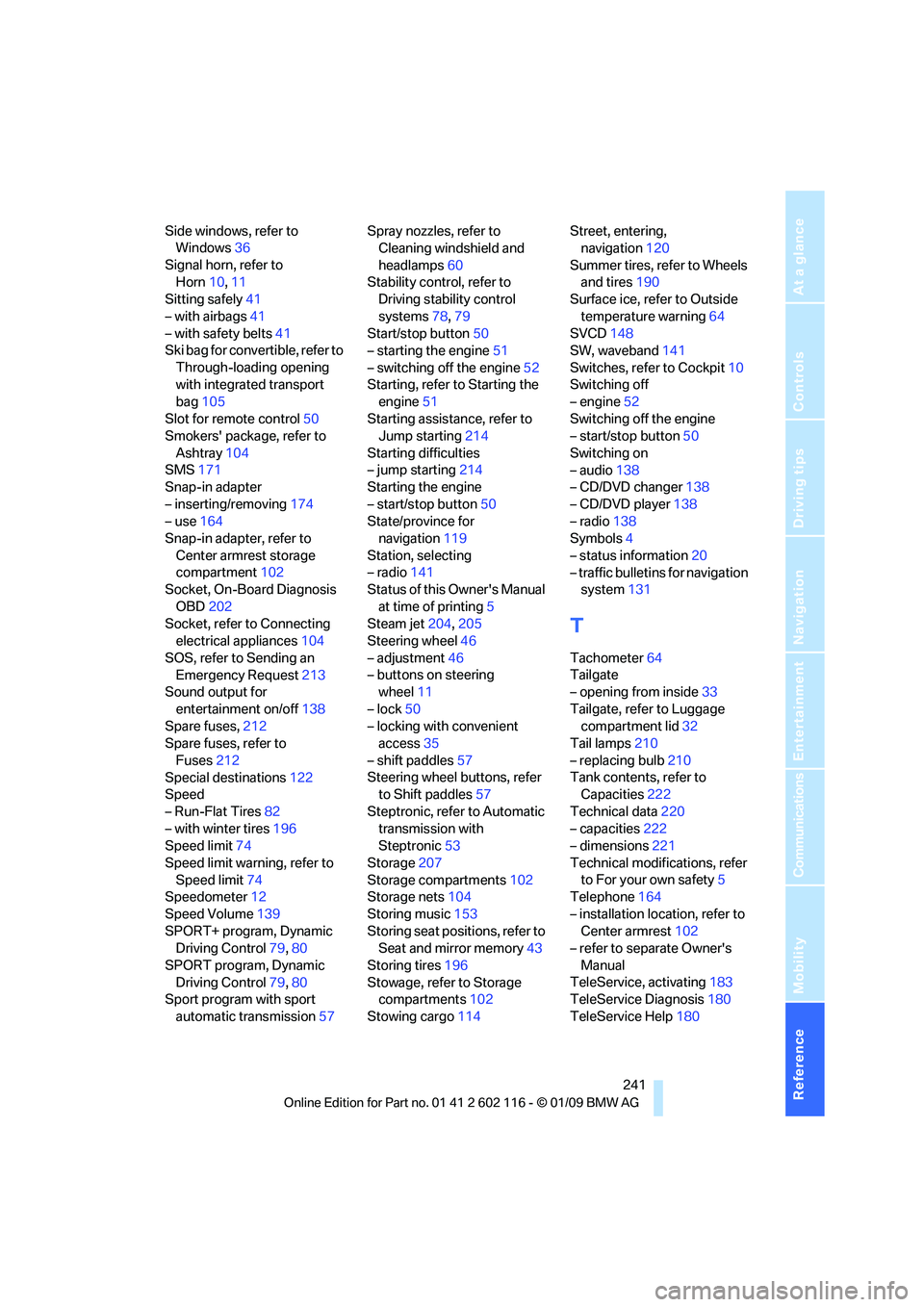2009 BMW Z4 SDRIVE30I ROADSTER spare tire
[x] Cancel search: spare tirePage 84 of 248

Technology for driving comfort and safety
82
3.
In the event of complete tire pressure loss,
0 psi/0 kPa, you can estimate the possible
distance for continued driving on the basis
of the following guidelines:
>With a light load:
1 person without luggage:
approx. 155 miles/250 km
> With a medium load:
1 person, cargo bay full, or 2 people
without luggage:
approx. 90 miles/150 km
> With a full load:
2 people, cargo bay full:
approx. 30 miles/50 km
Drive cautiously and do not exceed a
speed of 50 mph or 80 km/h, otherwise
there is a risk of an accident. In the event of
pressure loss, vehicle handling changes. This
includes reduced tracking stability in braking,
extended braking distance and altered natural
steering characteristics.
If unusual vibration or lo ud noises occur during
the journey, this may be an indication that the
damaged tire has finally failed. Reduce your
speed and pull over as soon as possible at a
suitable location. Otherw ise parts of the tire
could come loose, resulting in an accident. Do
not continue driving. Instead, contact your
BMW center. <
Status display
1."Vehicle Info"
2. "Vehicle status"
3. "Flat Tire Monitor"
The status is displayed.
Tire Pressure Monitor TPM*
The concept
TPM checks the inflation pressures of the four
mounted tires. The system notifies you if there
is a significant loss of pressure in one or more
tires.
Functional requirement
In order to assure the re liable reporting of a flat
tire, the system must be reset while all tire infla-
tion pressures are correct.
Always use wheels with TPM electronics. Oth-
erwise, the system may malfunction.
Each time a tire inflation pressure has
been corrected or a wheel or tire has been
changed, reset the system. <
System limitations
TPM cannot warn you in advance of sud-
den severe tire damage caused by out-
side influences. <
The system does not work correctly if it has not
been reset; for example, a flat tire may be indi-
cated even though the tire inflation pressures
are correct.
The system is inactive and cannot indicate a flat
tire if a wheel without TP M electronics, such as
a compact spare wheel, has been mounted, or if
TPM is temporarily malfunctioning due to other
systems or devices using the same radio fre-
quency.
Status indicator on the Control Display
The color of the tires represents the status of
the tires and the system.
TPM takes into account that tire pressures
change while the vehicl e is being driven. The
tire pressures do not need to be corrected
unless the TPM instructs you to do so by means
of color indicators.
Page 197 of 248

Mobility
195Reference
At a glance
Controls
Driving tips
Communications
Navigation
Entertainment
Tire age
For various reasons, such as the development
of brittleness, BMW recommends tire replace-
ment after no more than 6 years, regardless of
the actual wear of the tires.
The manufacturing date of tires is contained in
the tire coding:
DOT ... 0709 means that the tire was manufac-
tured in week 7 of 2009.
Run-Flat Tires
The symbol identifying Run-Flat Tires is a circle
with the letters RSC on the sidewall.
Run-Flat Tires comprise a conditionally self-
supporting tire and a special rim. The reinforce-
ment in the sidewalls ensures that the tire can
continue to be used su bject to certain restric-
tions, even if depressurized.
For information on continuing to drive with a flat
tire, refer to Indication of a flat tire, page 81.
New wheels and tires
Have new wheels and tires installed only
by your BMW center or tire shop that
works according to BMW repair procedures
with correspondingly trai ned personnel. If this
work is not carried out properly, there is a dan-
ger of subsequent dama ge and related safety
hazards. Make sure that the new wheels are bal-
anced. <
Retreaded tires
BMW recommends that you do not use
retreaded tires, since driving safety may
be impaired. The causes for this include poten-
tially different tire casi ng structures and often
wide variations in tire ag e, which can result in a
limited service life. <
Correct wheels and tires
When mounting new tires or changing over
from summer to winter tires and vice versa,
mount Run-Flat Tires for your own safety. In the
event of a flat, no spare wheel is available. Your
BMW center will be glad to advise you.
BMW recommends that you use only
wheel and tire combinations that BMW
has tested and approved for your particular
vehicle. Variations in factors such as manufac-
turing tolerances mean that even wheels and
tires with identical official size ratings could
actually have different dimensions, which could
lead to body contact and thus to severe acci-
dents. If non-approved wheels and tires are
used, BMW cannot evaluate their suitability,
and therefore cannot guarantee their driving
safety. <
You can inquire about the right wheel/tire com-
bination at your BMW center.
The correct combination of wheels and tires is
also necessary to ensure reliable operation of
various vehicle systems such as ABS, DSC
or TPM.
To maintain good handling and vehicle
response, use only tires of a single brand and
tread configuration. After a tire has been dam-
aged, mount the previous wheel and tire combi-
nation again as soon as possible.
Wheels with Tire Pressure Monitor
TPM electronics
When mounting new tires or changing over
from summer to winter tires, or vice versa, only
use wheels with TPM electronics; otherwise the
Tire Pressure Monitor may not be able to detect
a puncture, refer to page 82. Your BMW center
will be glad to advise you.
Page 213 of 248

Mobility
211Reference
At a glance
Controls
Driving tips
Communications
Navigation
Entertainment
2.Pull out the bulb holder, see arrow, and
change the bulb.
3. Attach the bulb holder.
4. Reattach the cover.
License plate lamp, rear lamp, center
brake lamp and turn signal
These lamps use LED technology for operation.
In the event of a malfunction, please contact
your BMW center or a workshop that works
according to BMW repair procedures with cor-
respondingly trained personnel.
Changing wheels
Your BMW is equipped with Run-Flat Tires as
standard. This removes the need to change a
wheel immediately in the event of a puncture.
For information on continuing to drive with a
damaged tire, refer to Indica tion of a flat tire on
page 81.
The symbol identifying Run-Flat Tires is a circle
with the letters RSC on the sidewall, refer to
Run-Flat Tires, page 195.
When mounting new tires or changing over
from summer to winter tires and vice versa,
mount Run-Flat Tires for your own safety. In the
event of a flat, no spare wheel is available. Your
BMW center will be glad to advise you. Refer
also to New wheels and tires, page 195.
The tools for changing wheels are avail-
able as optional accessories from your
BMW center. <
Jack mounting points
The jacking points are at the positions shown in
the illustration.
Lug bolt lock*
1Lug bolt for adapter
2 Adapter, in onboard tool kit
Removing the wind deflector
1.Remove the adapter 2 from the onboard
tool kit and insert it in the lug bolt.
2. Unscrew the lug bolt 1.
Remove the adapter after screwing the lug bolt
back on.
The code number is stamped on the front of the
adapter. Please note down this number and
keep it in a safe place in case the adapter should
get lost.
Page 243 of 248

Reference 241
At a glance
Controls
Driving tips
Communications
Navigation
Entertainment
Mobility
Side windows, refer to Windows 36
Signal horn, refer to Horn 10,11
Sitting safely 41
– with airbags 41
– with safety belts 41
Ski bag for convertible, refer to
Through-loading opening
with integrated transport
bag 105
Slot for remote control 50
Smokers' package, refer to
Ashtray 104
SMS 171
Snap-in adapter
– inserting/removing 174
– use 164
Snap-in adapter, refer to
Center armrest storage
compartment 102
Socket, On-Board Diagnosis
OBD 202
Socket, refer to Connecting electrical appliances 104
SOS, refer to Sending an Emergency Request 213
Sound output for
entertainment on/off 138
Spare fuses, 212
Spare fuses, refer to
Fuses 212
Special destinations 122
Speed
– Run-Flat Tires 82
– with winter tires 196
Speed limit 74
Speed limit warning, refer to Speed limit 74
Speedometer 12
Speed Volume 139
SPORT+ program, Dynamic Driving Control 79,80
SPORT program, Dynamic Driving Control 79,80
Sport program with sport
automatic transmission 57Spray nozzles, refer to
Cleaning windshield and
headlamps 60
Stability control, refer to Driving stability control
systems 78,79
Start/stop button 50
– starting the engine 51
– switching off the engine 52
Starting, refer to Starting the engine 51
Starting assistance, refer to Jump starting 214
Star
ting difficulties
– jump starting 214
Starting the engine
– start/stop button 50
State/province for navigation 119
Station, selecting
– radio 141
Status of this Owner's Manual
at time of printing 5
Steam jet 204,205
Steering wheel 46
– adjustment 46
– buttons on steering wheel 11
– lock 50
– locking with convenient access 35
– shift paddles 57
Steering wheel buttons, refer to Shift paddles 57
Steptronic, refer to Automatic transmission with
Steptronic 53
Storage 207
Storage compartments 102
Storage nets 104
Storing music 153
Storing seat positions, refer to Seat and mirror memory 43
Storing tires 196
Stowage, refer to Storage compartments 102
Stowing cargo 114 Street, entering,
navigation 120
Summer tires, refer to Wheels and tires 190
Surface ice, refer to Outside
temperature warning 64
SVCD 148
SW, waveband 141
Switches, refer to Cockpit 10
Switching off
– engine 52
Switching off the engine
– start/stop button 50
Switching on
– audio 138
– CD/DVD changer 138
– CD/DVD player 138
– radio 138
Symbols 4
– status information 20
– traffic bulletins for navigation system 131
T
Tachometer 64
Tailgate
– opening from inside 33
Tailgate, refer to Luggage compartment lid 32
Tail lamps 210
– replacing bulb 210
Tank contents, refer to Capacities 222
Technical data 220
– capacities 222
– dimensions 221
Technical modifications, refer to For your own safety 5
Telephone 164
– installation location, refer to Center armrest 102
– refer to separate Owner's
Manual
TeleService, activating 183
TeleService Diagnosis 180
TeleService Help 180